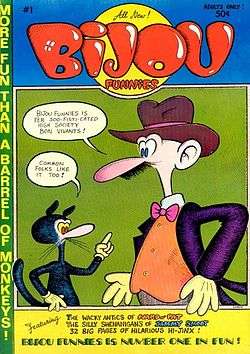Bijou Funnies
| Bijou Funnies | |
|---|---|
|
Cover of Bijou Funnies #1 (Bijou Publishing Empire, Summer 1968). Artwork by Jay Lynch. | |
| Publication information | |
| Publisher |
The Bijou Publishing Empire (1968) Print Mint (1969–1970) Kitchen Sink Press (1970–1973) |
| Schedule | sporadically |
| Format | standard |
| Publication date | Summer[1] 1968 – Nov. 1973 |
| Number of issues | 8 |
| Main character(s) |
Nard n' Pat Snappy Sammy Smoot The Fabulous Furry Freak Brothers Mr. Natural |
| Creative team | |
| Artist(s) | Jay Lynch, Art Spiegelman, Gilbert Shelton, Skip Williamson, Robert Crumb, Jay Kinney, Justin Green, Kim Deitch |
| Editor(s) | Jay Lynch |
| Collected editions | |
| The Best of Bijou Funnies | ISBN 978-0825630545 |
Bijou Funnies was an underground comix anthology that published eight issues from 1968–1973. Edited by Chicago-based cartoonist Jay Lynch, Bijou Funnies featured strong work by Lynch, Art Spiegelman, Gilbert Shelton, Skip Williamson, Robert Crumb, Jay Kinney, Justin Green, and Kim Deitch. Bijou Funnies was heavily influenced by Mad magazine,[2] and, along with Zap Comix, is considered one of the titles to launch the underground comix movement.[1]
Publication history
Bijou Funnies evolved from The Chicago Mirror, an underground newspaper co-produced by Jay Lynch and Skip Williamson, which published three issue in 1967–1968.[3] After seeing Robert Crumb's Zap Comix #1 (published in February 1968),[4] Lynch immediately converted the Mirror from a newspaper to a comic book and, under his own Bijou Publishing Empire produced the first issue of Bijou Funnies in summer 1968[1] (with Crumb as one of the contributors).
Bay Area publisher the Print Mint published issues #2-4 of the title from 1969–1970. The midwestern underground publisher Kitchen Sink Press took over Bijou Funnies with issue #5, publishing the title from 1970–1973.
ComixJoint's M. Steven Fox details what led to Bijou Funnies cancellation:
. . . a confluence of events formed the perfect storm and essentially ended the golden age of underground comics. The most critical event in that storm was the landmark Supreme Court decision on obscenity, which confirmed that obscenity was not protected by the First Amendment and established subjective guidelines for determining what constituted obscene material. The consequences of that ruling essentially destroyed the head shop distribution system that underground comics relied on to reach their audience.[1]
Eight issues of Bijou Funnies were published in all.
Quick Fox/Links Books published a collection titled The Best of Bijou Funnies in 1975.
Characters and contributors
Lynch's Nard n' Pat, a human-cat duo, were featured characters in Bijou Funnies. Williamson's Snappy Sammy Smoot made his debut in Bijou Funnies #1 and was a recurring character throughout the title's run. Williamson's Bozo Rebebo made frequent appearances as well. Crumb's Mr. Natural and Joey Tissue were recurring features; Shelton's The Fabulous Furry Freak Brothers appeared in issues #1 and #2.
The final issue, #8, is notable for a number of reasons. The inside front page contained an editorial from Lynch condemning the Supreme Court obscenity ruling. The cover was by Harvey Kurtzman, paying homage to his early work for Mad (but with an R-rated twist), and the stories inside were all parodies by the title's regular cartoonists of each other's characters.[5]
Issues
- (Bijou Publishing Empire, Summer 1968) — contributors: Skip Williamson, Jay Lynch, Robert Crumb, Gilbert Shelton, Dave Herring (2nd printing by Print Mint)
- (Print Mint, Sept. 1969) — contributors: Williamson, Lynch, Crumb, Art Spiegelman, Jim Osborne, Shelton, John Thompson, Rory Hayes, Paul David Simon ("Paul Filth"), Kim Deitch, Jay Kinney
- (Print Mint, Oct. 1969) — contributors: Lynch, Williamson, Roger Brand, Deitch, Kinney, Hayes, Dan Clyne, Crumb, Justin Green
- (Print Mint, May 1970) — contributors: Crumb, Williamson, Lynch, Deitch, Kinney, Clyne, Green (2nd printing by Kitchen Sink)
- (Kitchen Sink, Dec. 1970) — contributors: Williamson, Lynch, Osborne, Crumb, Green
- (Kitchen Sink, Sept. 1971) — contributors: Crumb, Lynch, Green, Williamson
- (Kitchen Sink, Nov. 1972) — contributors: Williamson, Spiegelman, Lynch, Crumb, Evert Geradts, Green, Clyne
- (Kitchen Sink, Nov. 1973) — contributors: Harvey Kurtzman (cover), Lynch, Don Stout, Williamson, Dennis Kitchen, Pat Daley, Crumb, Bill Griffith, Deitch, Green, Willy Murphy, Kinney, Ralph Reese
References
- 1 2 3 4 Fox, M. Steven. "Bijou Funnies," ComixJoint. Accessed Oct. 21, 2016.
- ↑ Sabin, Roger (1996). "Going underground". Comics, Comix & Graphic Novels: A History Of Comic Art. London, United Kingdom: Phaidon Press. pp. 92; 94–95; 103–107; 110; 111; 116; 119; 124–126; 128. ISBN 0-7148-3008-9.
- ↑ Schwartz, Ben. "Culture Jamming," Chicago Reader (June 25, 2004).
- ↑ Fox, M. Steven. "Zap Comix #1", ComixJoint. Accessed Oct. 21, 2016.
- ↑ Fox, M. Steven. ""Bijou Funnies #8", ComixJoint. Accessed Oct. 21, 2016.
External links
- Bijou Funnies at the Comic Book DB
